|
SpaceTides e-zine
#45 – 6 July 2006
Internet
Newsletter of ASSA Bloemfontein Centre, South
Africa, to the public
www.assabfn.co.za/spacetides

|
Subscribe to the free SpaceTides e-zine by
sending an e-mail to spacetides@assabfn.co.za
with the word "Subscribe" in the subject line if you are not
already subscribed. |
In this issue of SpaceTides |
INDEX
1. Spaceflight
news from around the world
2. Astronomy
news from around the world
3. Interesting
space facts
4. Sky
Observation log
5. Amateur
Astronomers' Corner
6. Astronomy
Events in the City of Bloemfontein
7. Astronomy
& Science in Southern Africa
8. Observatories
of the World
9. Photo
Sense
10 Web
links
Be sure to open this email in a full window by double clicking on it in your
inbox.
Winter
holiday edition...
Seems many
people are away on leave, probably gone to find warmer climes in the bushveld
and KwaZulu-Natal! But this issue of SpaceTides is overdue for some
time now; it has been a few hectic weeks.
Good news is that Shuttle Discovery made a successful launch towards
the ISS on 4 July 2006. It's been a controversial few days at NASA it
seems, with one of the top engineers resigning before launch due to apparent
safety issues.
There's a new section in SpaceTides called "Observatories of the
World". We'll put one of the most prominent observatories under the
spotlight. Sections will alternate in issues, keeping the maximum number of
sections 9 to 11.
Welcome to all the new subscribers who subscribed at Fascination Book
store in Bloemfontein on 1 July 2006 and in Kroonstad on 24 June
2006.
Remember that there is still opportunity to complete the feedback form for
SpaceTides.
Until the next issue!
Gerrit Penning
Editor
Total subscribers as at 6 July 2006: 555 (+27 from previous
issue #44) |
___________________________________________________________________________________________
1. Spaceflight news from around the world |

Image
credit: NASA. |
Launch of Shuttle Discovery successful
The space shuttle Discovery blasted off towards the International
Space Station on 4 July 2006 after a few days of delay. This is the
first shuttle launch in nearly a year! The shuttle will deliver supplies,
equipment and experiments to the station and test shuttle safety procedures.
Although a small crack was discovered in Discovery’s external fuel tank, NASA
decided the risk was small enough and proceeded with launch. The shuttle will
also bring a 3rd crew member to the station, astronaut Thomas Reiter. The
station has had a two-person crew since May 2003.
More at http://www.nasa.gov/mission_pages/shuttle/main/index.html |
________________________________________________________________________________________
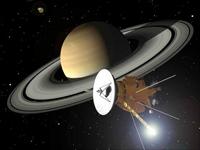
Artist
impression: JPL/NASA. |
Cassini mission reaches half-way mark
JPL/NASA
news release. 27 June 2006.
The Cassini spacecraft is reaching its halfway mark on its four-year visit of
the Saturn system. The satellite has been orbiting Saturn since 30 June 2004,
studying the planet, its rings and moons. Cassini has made 15 separate
flybys of Saturn's largest moon Titan and 30 more are planned for the
second half of its mission ending June 2008. Scientists are particularly keen
on investigating Titan as it might tell them something about the early Earth.
Well done Cassini, looking forward to the next two years of research!
Homepage: http://saturn.jpl.nasa.gov/home/index.cfm |
_________________________________________________________________________________________

Full
scale model of the JWST at GSFC in 2005. Source page. |
The James Webb Space Telescope of 2013
Information obtained from the JWST website.
The James Webb Space Telescope (JWST) will be a
large infrared telescope with a 6.5-meter primary mirror. It will be the
premier space observatory of the next decade. The telescope will be placed in
an orbit at a distance of about 1.5 million km away from the Earth and will
study every phase in the history of our Universe, ranging from the first
luminous glows after its formation, to the formation of solar systems capable
of supporting life on planets like Earth. Launch is planned for no
sooner than 2013.
There will be four science instruments on JWST: a near-infrared (IR) camera,
a near-IR multi-object spectrograph, a mid-IR instrument, and a tunable
filter imager.
Website: http://www.jwst.nasa.gov/ |
2. Astronomy news from around the world |

|
Supernova
Remnants from Chandra's camera. Chandra News Release,
3 July 2006
These four separate
images were photographed by the Chandra X-Ray Observatory, orbiting in space.
The remains of four supernovas (exploded stars) in the nearby Large
Magellanic Cloud galaxy puts up a display of some of nature's most explosive
events.
These X-ray images show multi-million degree gas that has been heated by
shock waves from the explosions. Moving clockwise from the upper left to the
lower left, the approximate ages of the remnants are 600 years, 1,500 years,
10,000 years and 13,000 years, respectively.
More information about Supernovas:
http://en.wikipedia.org/wiki/Supernova
Image credit: Chandra |
________________________________________________________________________________________

Image credit: Hubble
|
Two
Disks of Dust around Beta Pictoris
Hubble
News Release. 27 June 2006
Detailed photos of
the star Beta Pictoris (63 light years away) taken by Hubble show that it is
circled by two disks of dust and not just one. The best explanation for the
observations is that a suspected unseen planet, about one to 20 times the
mass of Jupiter and in an orbit within the secondary disk, is using gravity
to sweep up material from the primary disk. Additional material is attracted
to the planet, and is shaped into a second disk. The images offer
tantalizing new evidence for at least one Jupiter-size planet orbiting Beta
Pictoris. |
3. Interesting Space Facts |
________________________________________________________________________________________
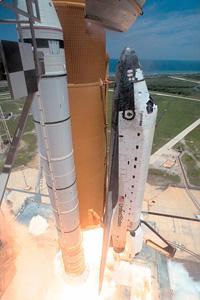
|
The Space Shuttle
-The outside skin of the shuttle can reach temperatures of up to 1 650 °C
upon re-entry into Earth’s atmosphere.
-After lift-off, it takes only about eight minutes for the Space Shuttle to
accelerate to its orbital speed of more than 27,300 kilometers per hour!
-The turbopump on the main engine of the Shuttle is so powerful that it can
drain an average family-sized swimming pool in only 25 seconds.
-The main engine of the Space Shuttle weighs only 1/7th as much as a train
engine does, but delivers as much horsepower as 39 locomotives.
-The Shuttle, on top of its launch pad, is transported by the so-called
"Crawler" vehicle, weighing an incredible 2 721 metric tons!
But, it travels at only 1.6 km/h when loaded… It takes the vehicle
almost five hours to travel from the Vehicle Assembly Building (VAB) to the
launch pad. (The two shuttle launch pads are respectively 5.5 and 6.8
km away from the VAB). |
Not sure
where to start with the night sky? Contact SpaceTides for assistance!
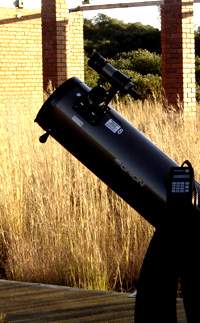
Orion 8 inch Dobsonian
reflector with Intelliscope. |
Planets
visible - July 2006
Mercury is visible just after sunset, for the first two weeks, after
which it comes too close to the sun's glare for observation. It reappears as a
morning object at the end of the month.
Venus is the bright morning object towards the east. You can't miss
it!
Earth is not too far away. In fact, it is known to come by once every
24 hours. It also offers its inhabitants one free ride around a star every
365 days. What a lot of fun. Hold on!!
Mars is situated in the evening sky in the north-west, shining with an
evident red colour.
Jupiter is also an evening object, shining very bright almost right
above you.
Saturn is setting in the north-west; it will only be visible until the
3rd week. If you have a telescope, catch it while you still can!
Constellations
and stars - July 2006
Some of the major early winter constellations now visible in the sky, on or
approaching the meridian in the evenings include:
To the North: Bootes (the Herdsman), Corona Borealis (the Northern Crown),
Mid-sky: Serpens Caput (the "left" snake), Ophiuchus (the Serpent
Carrier), Libra (the Balance) Scorpius (the Scorpion)
To the South: Lupus (the Wolf), Centaurus (the Centaur), Ara (the Altar).
Deep sky Objects - July 2006
Some of Scorpius's best objects include:
Binocular: M6 (the butterfly cluster), M7, NGC 6231 and surrounding
star field, NGC 6281 - a large star field/cluster. Telescope: NGC 6124
- a large open cluster with scattered stars of apparently equal brightness.
The globular cluster M4 is absolutely fantastic! Use a 6 inch and up - simply
superb.
Other constellations: find the globular cluster NGC 6397 in Ara and
search for the Messier globulars in Ophiuchus. For a real challenge
(and if you have a strong telescope with lots of patience and time), try your
hand at the galaxies and planetary nebulas in Lupus (magnitude 10 to
13!).
Other events
Full moon on 11 July 2006. New moon on 25 July 2006.
There are quite a few small meteor showers peaking during the month (Sky
Guide p. 74). |
5. Amateur Astronomers' Corner |

Image credit: Hannes Pieterse
More info about the Bloemfontein Centre's outreach activities at www.assabfn.co.za/education.htm.
|
Popularisation: The
Amateur Astronomer as an "Interface"
There are
many practical activities that an amateur astronomer can undertake, e.g.
solar observations, deep sky, occultations, astrophotography, history etc.
There is another activity though, that is fast becoming an important
component. That is "the popularisation of astronomy".
The amateur astronomer can act as the ideal interface between the
professional and the public. Amateurs usually have a crazy passion for the
subject, which comes in handy when you want to convey enthusiasm. Reaching
out to the layman and informing him/her about the wonders of science is a
very fulfilling experience - and you don't need to be a scientist.
Amateurs should join with professionals in the sense that both can contribute
to popularisation to a large extent, especially when done together.
Motivate your astronomy club to get involved in public outreach activities
and build contacts with professional astronomers. Many ASSA Centres have
frequent public open days or evenings. |
6. Astronomy Events in the City of Bloemfontein |

|
Volksblad
Kunstefees Sterre-vertonings / Arts Festival star shows
"Jy gaan jou sterre sien!" Letterlik! ASSA Bloemfontein bied
aan gratis sterrekunde vertonings op 12 en 13 Julie 2006 (Woensdag en
Donderdagaand), om 19h00 voor die Regsfakulteit (C.R. Swart-gebou) op die
kampus van die UV. Daar sal verskeie teleskope wees sowel as 'n
videoprojektor wat projeksies gaan maak van die konstellasies. Kom kyk ook
hoe laserwysers gebruik word om die sterre en planete uit te wys.
ASSA Bloemfontein Centre will present free star shows on the campus of the
UFS, in front of the Law Faculty (C.R. Swart building). Telescopes will be
available and a video projector simulating the constellations. It will take
place from 19h00 on both 12 and 13 July 2006. (Wednesday and Thursday
evening) Come and have a look how lasers are used to point out the stars and
planets.
|
__________________________________________________________________________________________
Bloemfontein Astronomy
websites:
Boyden Observatory: www.assabfn.co.za/friendsofboyden/boyden.htm
Friends of Boyden: www.assabfn.co.za/friendsofboyden
ASSA Bloemfontein: www.assabfn.co.za
For other SA Astronomy websites, go to the SpaceTides SA
Astronomy Portal at:
www.assabfn.co.za/spacetides/sa_astronomy.htm
_________________________________________________________________________________________
Onthou ook om die
maandelikse "Sterstof" artikels te lees, saamgestel deur ASSA
Bloemfontein, wat in die
Volksblad verskyn (laaste Saterdag van die maand).
7. Astronomy & Science in Southern Africa |
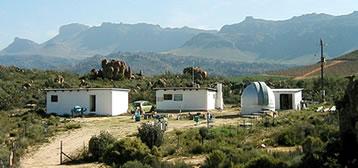
|
Cederberg
Astronomical Observatory
The Cederberg Astronomical Observatory is situated in the Cederberg Mountains
about 240 km north of Cape Town, on the farm Dwarsrivier. It is privately
owned, driven by 7 partners and has been in existence since the early
1980's. The observatory has the advantage of unpolluted dark skies and
a magnificent mountain view to recommend it. It's also an amateur
astronomer's paradise and members of the public are welcomed. There are
a wide range of various telescopes and other astronomical equipment.
More information at http://www.cederbergobs.org.za/
|
__________________________________________________________________________________________
For other SA Astronomy
websites, go to the SpaceTides SA Astronomy Portal at:
www.assabfn.co.za/spacetides/sa_astronomy.htm
8. Observatories of the World |
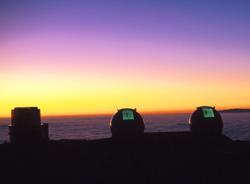
Subaru telescope
at far left, Keck telescopes centre and right. Photo credit: W.M. Keck
Observatory. |
W.
M. Keck Observatory
The Keck
Observatory is located in a remote outpost on the summit of Hawaii's dormant
Mauna Kea volcano. The main instruments used are the twin Keck Telescopes,
the world's largest optical and infrared telescopes. Each telescope's mirror
is 10 meters in diameter and is comprised of 36 hexagonal segments
that work together as a single piece of reflective glass.
The Observatory is operated by the California Association for Research
in Astronomy (CARA). The Keck I telescope began its observations in May 1993
and the Keck II began in October 1996. Each telescope is eight stories high
and weighs 300 tons! In addition, there are the 8.3 m Subaru Japanese
telescope and the 8.1 m Gemini North (Gillet) telescope. There are
also other infrared/optical telescopes, with a 3.8 meter aperture and
smaller.
Website: http://www.keckobservatory.org/ |
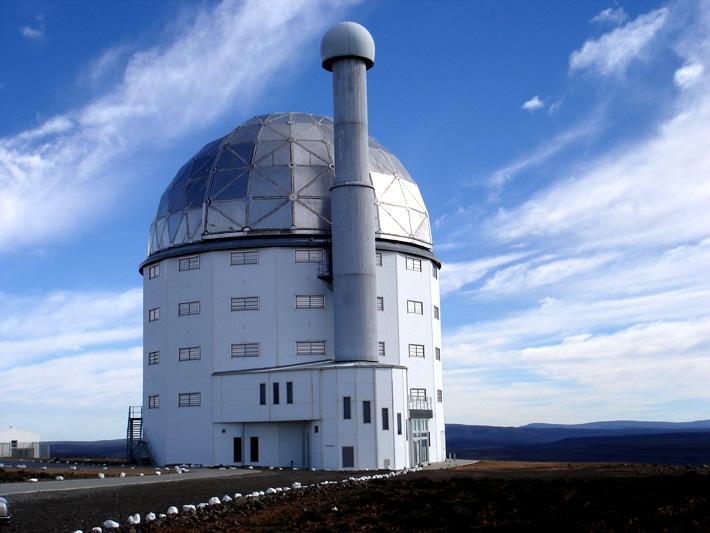
The dome of the South African Large Telescope (SALT). This photo was
taken by Colin Doyle (Somerset-West), during a visit to Sutherland in the
Northern Cape where the SAAO's observatory complex is situated. Camera used:
Sony DSC-W5, F/6.3. SALT website: www.salt.ac.za.
|
_____________________________________________________________________________________________________________________
SpaceTides is a free internet e-zine for persons interested in expanding
their general knowledge of astronomy and spaceflight.
The e-zine originates from the City of Bloemfontein in South Africa and is
compiled us a service to the public by ASSA Bloemfontein Centre
as part of their educational outreach activities. Website: www.assabfn.co.za.
SpaceTides contains links to various other third party sites on the
internet, not always connected to SpaceTides. The persons and entities
responsible
for compiling SpaceTides will not be held responsible for the content or
information on these third party sites or any damage of any kind incurred
from
downloading, opening, or viewing anything from/through these sites.
If you would like to unsubscribe from SpaceTides, send an e-mail to spacetides@assabfn.co.za with the word
"Unsubscribe" in the subject line.
_____________________________________________________________________________________________________________________________
|



